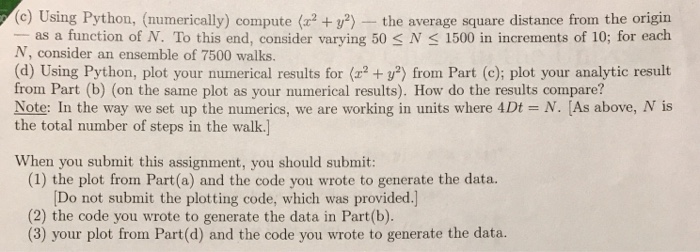You can just write code.
Thanks a lot.
Problem 4 Consider a pollen particle (i.e. a of dirt) the pollen particle is bombarded by the water molecules, it exhibits Brownian motion all piece of dirt) moving on the surface of a cup of water. Because the pollen particle moves randomly on the water's surface. To model this Brownian motion, we will consider a particle exhibiting a random wa starts at the origin; at each step (of the walk).1] one of 4 "moves" is chosen at random: (1) one step in positive-x (2) one step in negative-x (3) one step in positive-y (4) one step in negative-y (a) (i) Using Python, generate a walk of N=500 steps. (ii) Plot this particular walk. make this plot, use the code "plotbrown,py" which is in the Assignment folder (in the course's Blackboard site) Note: To use "plotbrown.py", save your data (for the random walk) in a file named "browndata.dat". For the rest of this problem, we will consider how the walk depends on the number of steps takern, (b) In (one of!) Einstein's seminal work(s), he determined the probability for a Brownian particle to be at position (x,y) relative to its starting point (0,0): r, y) =--exp 1Dt where D is the "diffusion constant (which is a function of temperature), and t is the time. Using that the average value of a quantity f (z, y) is obtained via (f(x,y)) = | dxdyP(x,y) f(x,1) , where P(z,y) is the probability distribution, compute (2+ ') (with P(s, y) given by Eq. 2). Problem 4 Consider a pollen particle (i.e. a of dirt) the pollen particle is bombarded by the water molecules, it exhibits Brownian motion all piece of dirt) moving on the surface of a cup of water. Because the pollen particle moves randomly on the water's surface. To model this Brownian motion, we will consider a particle exhibiting a random wa starts at the origin; at each step (of the walk).1] one of 4 "moves" is chosen at random: (1) one step in positive-x (2) one step in negative-x (3) one step in positive-y (4) one step in negative-y (a) (i) Using Python, generate a walk of N=500 steps. (ii) Plot this particular walk. make this plot, use the code "plotbrown,py" which is in the Assignment folder (in the course's Blackboard site) Note: To use "plotbrown.py", save your data (for the random walk) in a file named "browndata.dat". For the rest of this problem, we will consider how the walk depends on the number of steps takern, (b) In (one of!) Einstein's seminal work(s), he determined the probability for a Brownian particle to be at position (x,y) relative to its starting point (0,0): r, y) =--exp 1Dt where D is the "diffusion constant (which is a function of temperature), and t is the time. Using that the average value of a quantity f (z, y) is obtained via (f(x,y)) = | dxdyP(x,y) f(x,1) , where P(z,y) is the probability distribution, compute (2+ ') (with P(s, y) given by Eq. 2)








